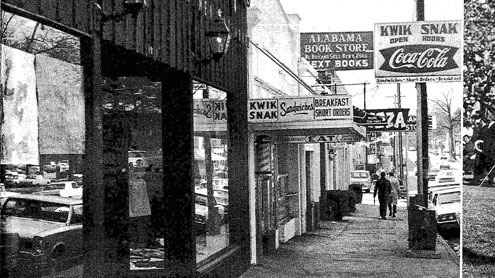 The Ivory Tusk, The Pitcher Show and Solomon’s Deli. For current University of Alabama students, these names hold no value. However, for UA alumni, these names stand for bars, theatres and restaurants that dominated their time spent in Tuscaloosa. These businesses have come and gone as the decades passed, ushering in a new look for the Strip. But the changing facade of the Strip has not slowed over the past few years, and only a few businesses remain that have withstood decades of growth.
The Ivory Tusk, The Pitcher Show and Solomon’s Deli. For current University of Alabama students, these names hold no value. However, for UA alumni, these names stand for bars, theatres and restaurants that dominated their time spent in Tuscaloosa. These businesses have come and gone as the decades passed, ushering in a new look for the Strip. But the changing facade of the Strip has not slowed over the past few years, and only a few businesses remain that have withstood decades of growth.
One such business that has remained a constant over the years is the Alabama Book Store. Sitting in its current location since 1942, the Alabama Book Store has witnessed many changes in the Strip’s character.
David H. Jones, the grandson of the founder and a buyer at the Alabama Book Store, has seen many changes to the Strip and said the most drastic has been the introduction of the strip mall style of buildings.
“A lot of the character is gone [from the Strip]. The block down the road that used to house The Booth, Lai Lai and Pepito’s was unique-looking, and now it’s all glass facades, which is kind of boring,” Jones said. “It looks nice, but there’s no character to them.”
Home to places such as Rex Pharmacy, presently The Crimson Cafe, and The Twin Tide Theaters, which was housed where the Dixie currently is located, the Strip of the 1950s and 1960s featured many different types of businesses and building styles. Additionally, the Strip was not the entertainment center that it eventually became known as.
This role was introduced in the 1970s, with the repeal of a law that did not allow alcohol to be served within a close proximity to UA’s campus. With this repealed, bars began to appear on the Strip. Gallettes, founded in 1976, and Egan’s, 1977, are the two oldest bars on the Strip. The Houndstooth, founded in 1988, has also remained a fixture on the Strip.
Tom Hammond, a floor salesman for 14 years at The Locker Room, a clothing store that has been in its location on the Strip since 1966, said that the Strip is almost “completely different than when we started out.”
“There was a pool hall across the street that’s no longer here. There was a Krystal’s where Waffle House is now. There were more bars than now. Some of the bars are gone,” he said. “We’ve seen Publix come in. The Houndstooth has been completely revamped, rebuilt.”
In addition to these changes, the University Town Center, a strip mall style complex, opened in 2002 and offers a number of diverse businesses. And, like the Strip over the decades, the businesses within the complex have changed over the years. Strip Teas and Coffee and Qdoba closed, eventually being replaced by TCBY and Moe’s Southwest Grill.
The elimination of bars is an important transition in the Strip’s history. In 2003, the Tuscaloosa City Council voted to restrict alcohol serving hours, forcing bars to close at 2 a.m. most nights. Many bars have come and gone. Where Rounders currently is located, The Ivory Tusk, The Venue and The Legacy – all bars – have opened and closed since the 1980s. Additionally, in 2006, The Booth, which opened in 1981, closed. Its previous location on the Strip housed The Woodlands leasing office and will soon be home to Woods and Water Outdoors. The Booth reopened in a new downtown location in 2009.
Hammond does not anticipate many more changes the Strip’s current bar scene.
“There have been a couple [bars] that were ousted when their leases were up … [but] as quickly as that started, it pretty much stopped,” Hammond said. “I don’t think there will be any new growth in that area, but I don’t think there will be any less, either. I think the ones that are here are firmly in place.”
Despite attempts to clean up the Strip’s bar scene, Hammond thinks it will remain a party street.
“I think it’s still a party street. I think it always will be, even though there are fewer bars,” he said. “I don’t think you’re going to be able to change that.”
Jones said that although the character of the Strip has changed, its role as a gathering place for both University students and residents remains.
“It’s definitely a gathering place, especially from 10 o’clock to 2 o’clock… It’s a small little community upon itself. You’ve got Publix, all the bars and a few nicer restaurants, national chain foods, you’ve got us, The Locker Room, businesses that sell Alabama apparel… You can pretty much get what you need in this area.”
To read more about UA’s influence on the Strip, read Monday’s The Crimson White.









